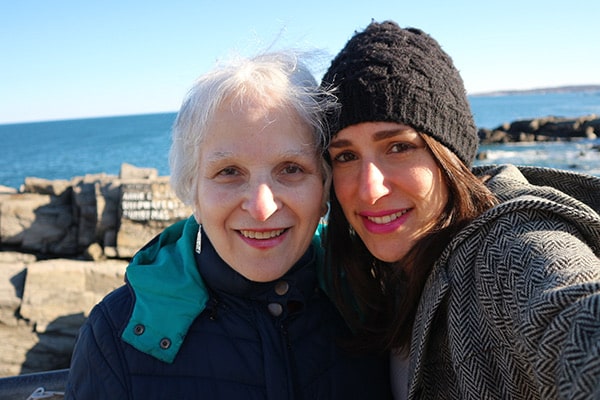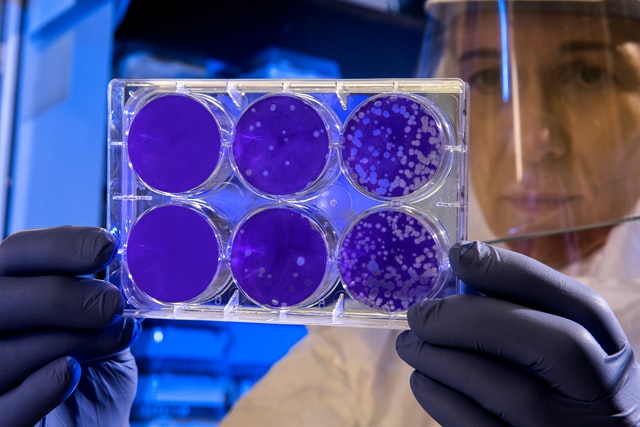Three years ago, writer Rachel Sampson was handed her mother’s death certificate. It read, “rapid neurocognitive decline, etiology unknown.” She reflects on that harried and heartbreaking experience of loss and lockdown, and on the through lines of love and presence.
A matter of days before my mom died, my therapist told me there was no more fight to be had, nothing more to be fixed. She told me to just focus on being with my mom, who was 45 miles north in hospice. It was a month into a pandemic that had arrived at all of our doorsteps. Sitting there at the kitchen counter in the stillness of my childhood home, I slowly closed my laptop and told myself my mantra would be presence. Presence and peace for my mom with our time left.
In March of 2020, I knew that I was straddling the unimaginable border between a before and an irrevocably altered after, a world without my mother — all poetically enmeshed with the same seismic before and after on a global scale. The world as I (and we) knew it was forever changed.
Two of the most excruciating weeks in those months of advocating for my mother came as I was locked out of Yale New Haven Hospital on March 15, 2020, with her still inside.
There were murmurs that a lockdown was imminent as the nurses whispered around me, informing me that they had to move my mom again. I pleaded with them to stop transferring her from room to room, which is highly distressing for someone with dementia who is already agitated and confused.
What they weren’t telling me was that they were bringing the first Covid patients onto the unit. In those early days, we were all figuring it out together; there were no protocols, let alone masks. In a matter of days, my mom surely would have no idea why I wasn’t there, or that a pandemic was raging outside.
Following spinal taps, genetic testing, and so much more, there were no firm answers as to the root cause of her deterioration. (Years of research lie ahead when it comes to our understanding of myriad atypical dementias, neuropsych issues, or even Parkinson’s disease.) With a palliative care team and her loving, steadfast doctor, the only avenue left unexplored for my mom as the pandemic hit was electroconvulsive therapy (ECT). But she had filled out her directive years prior, ticking off “no” to this form of treatment.
By the time my therapist told me there was no more fight to be had, I had raged at many, including lawyers who filled out such directives with clients. I felt sure a lawyer could not understand the ramifications of these medical checklists, let alone counsel their clients with such nuance regarding these points. I imagined a box such as this one being glossed over as nothing more than of the “One Flew Over the Cuckoo’s Nest” ilk. What if ECT could have helped my mom?, I thought.
But the truth is, it was time for peace. There had been so many fights along the way. To be heard. To be taken seriously. In navigating the healthcare system, the stigmas, the continuity of care, the drug protocols, the assisted living facilities, the ER visits, the delirium … the pandemic. The exhausting task of wiping down the groceries when I came home to an empty house day in and out, lonely, in pain, and grieving my mom with every next knock down.

Along with her doctor and social worker, I worked to get my mom out of a locked-down hospital and over to a hospice just north of Yale, where we ultimately found an available bed. She didn’t yet meet the threshold for this hospice via the Medicare barometers, but I was not going to be robbed of any more critical time with her by that point, even if it meant we must self-pay. On April 1, 2020, I raced north on an eerily empty highway to hug my mom after 15 days of separation. The radio droned on in the background during those drives north, breaking news on every aspect of this unfolding pandemic — news I barely absorbed until months later, with only the fight for my mom right in front of me.
They took my temperature by forehead upon entering hospice, and gave me one of the cloth masks that local seamstresses were churning out. I was to sign one out and return it when I left each day, at which point they were sanitized and reused. On the days I found the colors and patterns I loved, I didn’t sign them back in, stashing away a new cache for a new world.
As with every part of my journey with my mom, the head of hospice told me that while he can usually stand over someone upon admission and predict how they are going to die, he did not know with my mother. As usual, my mom was “complex.” He said he saw a woman in an advanced stage of a disease, but, from there, it remained to be seen. This gave me a small, fleeting hope that she might graduate out of hospice, that it wasn’t always a death sentence. Perhaps she’d make it to a care facility when lockdown across the region lifted, one near my brother that he and I were exploring.
After fighting the rotating staff at hospice that first week to continue to get her dressed and upright, I decided to focus on peace and presence. After reiterating that the notes in the chart were not passed on correctly from shift to shift, that my mom arrived there as someone who only needed a one-person assist to stand, and not a Hoyer lift, I decided to focus on peace and presence.
For 24 days straight, I drove the empty highways back and forth to be with her. It was a blessing, with alchemy not lost on me, given that most nursing homes and long-term care facilities were shut down to visitors. Covid only came to this hospice a couple weeks after my mom died.
I was blessed to be able to hug my mom and wheel her out for some fresh air against the backdrop of Long Island Sound while she shouted about poplar trees. I could see some peace wash over her face as she felt the sun. At one point she also told me that I had a secret for the deaf community — the brain is a funny thing.
I was blessed to make her matzah ball soup one last time as Passover arrived. I tried to get her to eat as much as possible, but I learned, as many of us must who care for loved ones with late-stage dementia, that food was not on her brain’s radar, with the nurses often logging only four bites of each meal. A couple of months prior, the tipping point from plump, happy mom devouring her food to confused mom looking suddenly skinny was a distressing one. A slow realization. And a calorie deficit is hard to come back from over time.
I watched in those last days as she began to gently choke as she drank, at which point I instead gave her pipettes of cranberry juice, and finally, wet lollypop-shaped sponges on the inside of her cheek. It was a natural process, and she was at peace.
It is only now, nearly three years later, that I can process the entirety of that time with some distance. The truth is, I will always have a mother in this world, who lives as part of the light behind my own heart. And despite being handed that death certificate after navigating murky waters when it comes to brain health and teasing out neuropsych symptoms and disorders, I now know that I did everything right. By virtue of reading this, I am certain that you, too, should trust that you have done the same, whether an advocate, caretaker, friend, relative, or daughter like me.
Because leading with love endures beyond all else. Love never stops being familiar to someone with degenerative brain disease, even while their words come out in a nonsensical scramble, even when their smile looks a little flat and contorted, even when their swallowing reflexes slowly shut down. And even when you wonder if their addled brain can understand anything, hoping so much so as you lay next to them, telling them everything you are thankful to them for in their last days.
It is not the words that matter because they will never not recognize patience and kindness. And they will never not know your voice — with the familiarity and love and comfort that it holds.
A mother will never not know her daughter’s voice. And on April 24, 2020, the day mine died, only one bizarre, otherworldly groan came from within her. Because as soon as my voice was put to her ear, she never made a sound again. I sang to her as I sped through blinding rain to get there in time — Judy Collins, James Taylor, and the lullabies she had sung to me. I spoke everything I could think of as I sent her off enveloped peacefully in not the words, but in the voice of her daughter. And as I wrapped my arms around her with a matter of moments to spare, I will never forget the gift of being present.
Rachel Sampson is a freelance writer and editor based in New York and Berlin, whose clients have included Penguin Random House, T Brand, Apple, Monocle, and Gestalten.





RACHEL… YOU WERE A WONDERFUL CARING DAUGHTER AND DID EVERYTHING POSSIBLE TO MAKE MOM COMFORTABLE AND HAPPY, AS MUCH AS YOU COULD HAVE DONE,FOR HER AT THAT TIME. SHE KNEW HOW MUCH YOU LOVED AND CARED FOR HER SHE IS MISSED BY SO MANY PEOPLE HOPE YOUR AT PEACE YOURSELF NOW A DAYS